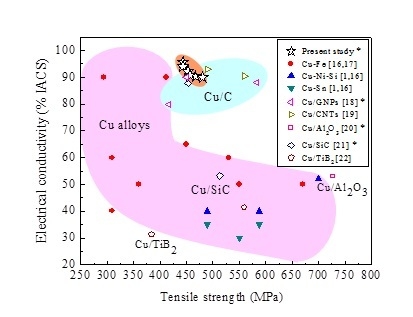Hard Copper with Good Electrical Conductivity Fabricated by Accumulative Roll-Bonding to Ultrahigh Strains
Abstract
:1. Introduction
2. Experimental Procedure
3. Results and Discussion
4. Conclusions
Acknowledgements
Author Contributions
Conflicts of Interest
References
- Tomioka, Y.; Miyake, J. A copper alloy development for leadframe. In Proceedings of 1995 Electronic Manufacturing Technology Symposium, Omiya, Japan, 4–6 December 1995; pp. 433–436.
- Suzuki, S.; Shibutani, N.; Mimura, K.; Isshiki, M.; Waseda, Y. Improvement in strength and electrical conductivity of Cu–Ni–Si alloys by aging and cold rolling. J. Alloy. Compd. 2006, 417, 116–120. [Google Scholar] [CrossRef]
- Lu, D.P.; Wang, J.; Zeng, W.J.; Liu, Y.; Lu, L.; Sun, B.D. Study on high-strength and high-conductivity Cu-Fe-P alloys. Mater. Sci. Eng. A 2006, 421, 254–259. [Google Scholar] [CrossRef]
- Ghosh, G.; Miyake, J.; Fine, M.E. The systems-based design of high-strength, high-conductivity alloys. JOM 1997, 49, 56–60. [Google Scholar] [CrossRef]
- Tsuji, N.; Saito, Y.; Lee, S.H.; Minamino, Y. ARB (Accumulative Roll-Bonding) and other new Techniques to Produce Bulk Ultrafine Grained Materials. Adv. Eng. Mater. 2003, 5, 338–344. [Google Scholar] [CrossRef]
- Shaarbaf, M.; Toroghinejad, M.R. Nano-grained copper strip produced by accumulative roll bonding process. Mater. Sci. Eng. A 2008, 473, 28–33. [Google Scholar] [CrossRef]
- Jang, Y.; Kim, S.; Han, S.; Lim, C.; Goto, M. Tensile behavior of commercially pure copper sheet fabricated by 2- and 3-layered accumulative roll bonding (ARB) process. Met. Mater. Int. 2008, 14, 171–175. [Google Scholar] [CrossRef]
- Saito, Y.; Utsunomiya, H.; Tsuji, N.; Sakai, T. Novel ultra-high straining process for bulk materials—Development of the accumulative roll-bonding (ARB) process. Acta Mater. 1999, 47, 579–583. [Google Scholar] [CrossRef]
- Kunimine, T.; Fujii, T.; Onaka, S.; Tsuji, N.; Kato, M. Effects of Si addition on mechanical properties of copper severely deformed by accumulative roll-bonding. J. Mater. Sci. 2011, 46, 4290–4295. [Google Scholar] [CrossRef]
- Suresh, K.S.; Sinha, S.; Chaudhary, A.; Suwas, S. Development of microstructure and texture in Copper during warm accumulative roll bonding. Mater. Charact. 2012, 70, 74–82. [Google Scholar] [CrossRef]
- Jang, Y.H.; Kim, S.S.; Han, S.Z.; Lim, C.Y.; Kim, C.J.; Goto, M. Effect of trace phosphorous on tensile behavior of accumulative roll bonded oxygen-free copper. Scr. Mater. 2005, 52, 21–24. [Google Scholar] [CrossRef]
- Jamaati, R.; Toroghinejad, M.R. Application of ARB process for manufacturing high-strength, finely dispersed and highly uniform Cu/Al2O3 composite. Mater. Sci. Eng. A 2010, 527, 7430–7435. [Google Scholar] [CrossRef]
- Xing, Z.P.; Kang, S.B.; Kim, H.W. Structure and properties of AA3003 alloy produced by accumulative roll bonding process. J. Mater. Sci. 2002, 37, 717–722. [Google Scholar] [CrossRef]
- Eizadjou, M.; Manesh, H.D.; Janghorban, K. Microstructure and mechanical properties of ultra-fine grains (UFGs) aluminum strips produced by ARB process. J. Alloy. Compd. 2009, 474, 406–415. [Google Scholar] [CrossRef]
- Shih, M.H.; Yu, C.Y.; Kao, P.W.; Chang, C.P. Microstructure and flow stress of copper deformed to large plastic strains. Scr. Mater. 2001, 45, 793–799. [Google Scholar] [CrossRef]
- Ma, J.S.; Huang, F.X.; Huang, L.; Geng, Z.T.; Ning, H.L.; Han, Z.Y. Trends and development of copper alloys for lead frame. J. Funct. Mater. 2002, 33, 1–4. [Google Scholar]
- ASM handbook committee. Metals Handbook Volume 2, 9th ed.; ASM: Metals Park, OH, USA, 1979; pp. 310–313. [Google Scholar]
- Chen, F.; Ying, J.; Wang, Y.; Du, S.; Liu, Z.; Huang, Q. Effects of graphene content on the microstructure and properties of copper matrix composites. Carbon 2016, 96, 836–842. [Google Scholar] [CrossRef]
- Arnaud, C.; Lecouturier, F.; Mesguich, D.; Ferreira, N.; Chevallier, G.; Estournès, C.; Weibel, A.; Laurent, C. High strength–High conductivity double-walled carbon nanotube–Copper composite wires. Carbon 2016, 96, 212–215. [Google Scholar] [CrossRef]
- Rajkovic, V.; Bozic, D.; Stasic, J.; Wang, H.; Jovanovic, M.T. Processing, characterization and properties of copper-based composites strengthened by low amount of alumina particles. Powder Technol. 2014, 268, 392–400. [Google Scholar] [CrossRef]
- Efe, G.C.; Yener, T.; Altinsoy, I.; Ipek, M.; Zeytin, S.; Bindal, C. The effect of sintering temperature on some properties of Cu-SiC composite. J. Alloy. Compd. 2011, 509, 6036–6042. [Google Scholar]
- López, M.; Corredor, D.; Camurri, C.; Vergara, V.; Jiménez, J. Performance and characterization of dispersion strengthened Cu-TiB2 composite for electrical use. Mater. Charact. 2005, 55, 252–262. [Google Scholar] [CrossRef]
- Zhang, P.; Li, S.X.; Zhang, Z.F. General relationship between strength and hardness. Mater. Sci. Eng. A 2011, 529, 62–73. [Google Scholar] [CrossRef]
- Cahoon, J.R.; Broughton, W.H.; Kutzak, A.R. The determination of yield strength from hardness measurements. Metall. Trans. 1971, 2, 1979–1983. [Google Scholar]




© 2016 by the authors; licensee MDPI, Basel, Switzerland. This article is an open access article distributed under the terms and conditions of the Creative Commons Attribution (CC-BY) license (http://creativecommons.org/licenses/by/4.0/).
Share and Cite
Yao, G.; Mei, Q.; Li, J.; Li, C.; Ma, Y.; Chen, F.; Zhang, G.; Yang, B. Hard Copper with Good Electrical Conductivity Fabricated by Accumulative Roll-Bonding to Ultrahigh Strains. Metals 2016, 6, 115. https://doi.org/10.3390/met6050115
Yao G, Mei Q, Li J, Li C, Ma Y, Chen F, Zhang G, Yang B. Hard Copper with Good Electrical Conductivity Fabricated by Accumulative Roll-Bonding to Ultrahigh Strains. Metals. 2016; 6(5):115. https://doi.org/10.3390/met6050115
Chicago/Turabian StyleYao, Gongcheng, Qingsong Mei, Juying Li, Congling Li, Ye Ma, Feng Chen, Guodong Zhang, and Bing Yang. 2016. "Hard Copper with Good Electrical Conductivity Fabricated by Accumulative Roll-Bonding to Ultrahigh Strains" Metals 6, no. 5: 115. https://doi.org/10.3390/met6050115
APA StyleYao, G., Mei, Q., Li, J., Li, C., Ma, Y., Chen, F., Zhang, G., & Yang, B. (2016). Hard Copper with Good Electrical Conductivity Fabricated by Accumulative Roll-Bonding to Ultrahigh Strains. Metals, 6(5), 115. https://doi.org/10.3390/met6050115






